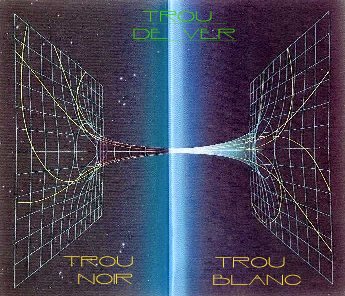Contrary to what you might expect, Sliders is actually based on real science. Indeed, the idea of parallel worlds may seem on the face of it to be pure fantasy, but for many scientists, it is much more than mere science-fiction.
Einstein's theory of relativity predicted the existence of "black holes", a hypothesis which has since been verified. These cosmic phenomena arise from the death of a star, after it collapses in on itself under the force of its own gravity. Inside a black hole, gravity is so intense that even light cannot escape the gravitational field (hence the name black hole).
Albert Einstein and another physicist by the name of Nathan Rosen posited that each black hole would symmetrically on another gravitational well called a white hole (or sometimes also white fountain). The black hole/white hole pair would form a "wormhole", or vortex (the interdimensional passage used by the Sliders, called an Einstein-Rosen Bridge).
Thus, any matter swallowed up by the black hole would be quickly spat out by the white hole, in an unknown location... This could be either a distant point in the universe, in which case the wormhole would act as a shortcut through space and time. Alternatively, it could be a parallel universe, in which case it would act as a bridge between the different dimensions.

The second hypothesis could explain the total absense of antimatter in the universe as we know it. According to the universe's governing principle of symmetry, there must be equal amounts of matter and antimatter. However, we have failed to discover the slightest trace of the latter, although we have succeeded in producing it artificially (at the CERN laboratory in Geneva, Switzerland in 1995, and in other particle accelerators). The existence of parallel universes could explain the lack of antimatter in our world. In parallel dimensions, then, there could be objects similar to the planets and stars we are familiar with in our own, but constructed of antimatter (this is one of the most recent theories, after the principles of dissymetry, and of the annihilation frontier).
According to a poll of 72 leading physicists conducted by the American researcher David Raub in 1995 (published in the French periodical Sciences et Avenir in January 1998), the multiple universe theory is widely accepted:
| 58% of physicists (including Stephen Hawking) think multiple universes exist |
| 18% (including Roger Penrose) do not accept this theory |
| 13% admit the possibility, but remain unconvinced |
| and 11 % have no opinion. |
Sadly, we are not yet able to cross these bridges, if they exist. In fact, it would require a tremendous amount of energy to open a wormhole artificially, and the gravitational force inside would be so strong that we would be completely crushed.
Thus, Quinn must be a true genius to be able to open an interdimensional vortex so easily and quickly, and without suffering any injury!
Those who believe time travel may be possible rely similarly on the existence of parallel universes, which would allow for the resolution of the "grandfather paradox":
If a man were to go back in time and kill his grandfather as a child, logically speaking he would not be born, since his father before him would not be born. But if he wasn't born, he can't go back and kill his grandfather, therefore his grandfather lives, and the grandson is eventually born, therefore he can kill his grandfather, and so on...
If you consider that wormholes are shortcuts through the space-time continuum, the man could use one to go kill his grandfather. However, he would arrive not in the past of his own universe, but instead in that of a parallel universe, in which his existence does not depend on the continued existence of his grandfather. In killing this version of his grandfather, he would simply be preventing the birth of his double in the parallel universe...
Recommended reading:
In Search of Schrodinger's Cat: by John Gribbin
- Bantam Doubleday Dell
La Physique Quantique by Etienne Klein - Editions Dominos
Flammarion (no English translation available)
Sources : Science et Avenir - January
1998, Science&Vie #950, In Search of Schrödinger's Cat by
John Gribbin.
Thanks to John Fuller for the translation !

To slide to the main pages of the site, use the buttons of the timer...